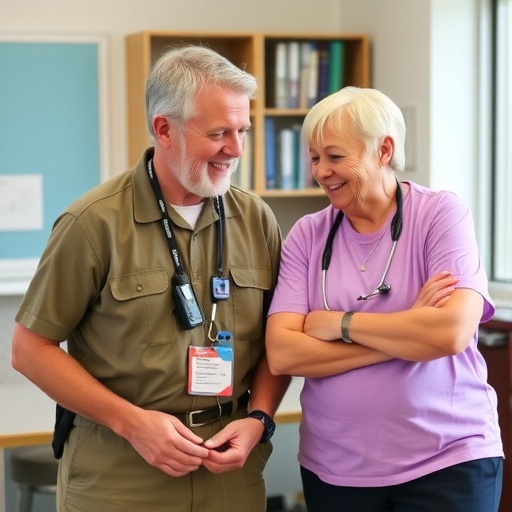
Perceiving personal health risks is a complex and nuanced process that often hinges on an individual’s ability to quickly assess the trustworthiness of others. This intricate dance between judgment and perception can be particularly impactful in scenarios where health risks, especially those involving sexually transmitted diseases (STDs), are in question. The latest research spearheaded by Daniela Mier from the University of Konstanz delves deep into the neural mechanisms behind these judgments, providing enlightening insights into how our brains navigate trust and perceived risk.
In a groundbreaking study published in the esteemed journal eNeuro, Mier’s team explored the relationship between perceived trustworthiness, the likelihood of HIV transmission, and brain activity. Previous investigations had hinted at the involvement of specific brain regions when individuals evaluate others for trustworthiness. However, this new research paints a more comprehensive picture of how trust perceptions can shape one’s neurobiological responses and influence risk assessments.
Participants in the study were presented with pictures of different individuals and tasked with rating these individuals based on their perceived trustworthiness. These images were previously curated to reflect varying odds of HIV transmission, offering a unique opportunity for Mier’s team to correlate visual stimuli with subjective assessments and brain activity. Intriguingly, it was discovered that individuals depicted with lower perceived risks of HIV transmission were generally rated as more trustworthy by participants.
This finding suggests that the brain may have evolved mechanisms to reflexively associate lower health risks with higher trustworthiness, possibly functioning as a cognitive shortcut to facilitate social interactions. Brain imaging techniques revealed that when participants judged an individual as trustworthy, especially alongside a lower perceived risk of HIV transmission, there was heightened activity within a region of the brain known as the reward network. This neural activation may serve as a safety signal, reinforcing trust and promoting social bonding.
In contrast, when participants perceived high odds of HIV transmission, individuals were significantly more likely to be classified as untrustworthy. This shift in perception is not merely a social judgement but seems to engage another distinct neural system— the salience network. When participants expressed distrust, particularly in scenarios where they believed there to be a heightened health risk, the salience network demonstrated heightened activity. This response is indicative of an “alarm signal” in the brain, alert to potential threats in the social environment.
The implications of Mier’s research stretch beyond the laboratory. Understanding how the brain processes trust and risk perception could have real-world applications, particularly in educational and public health contexts. For instance, the revelations of this study might inform strategies for health communication, emphasizing the importance of trust in fostering safe sexual practices and reducing the stigma associated with STDs. By elucidating the brain’s reactions to perceived trustiness and risk, we may also uncover pathways to enhance public health initiatives aimed at increasing awareness and preventive measures.
Moreover, these findings underscore the innate complexity of human social interactions. By demonstrating how cognitive biases can influence not only perceived trustworthiness but also corresponding neurobiological responses, the research prompts a reevaluation of how societal perceptions can shape health outcomes. If our judgments about others can trigger distinct neural pathways linked to either safety or danger, the ramifications are profound—potentially affecting societal beliefs about risk and trust in larger public consciousness.
In an era where misinformation can ebb and flow through social networks, understanding the nuances of how trust operates on a neural level takes on added importance. The study also raises questions about the role of external cues and contextual factors in shaping trust. As our brains evaluate and navigate complex social landscapes, there remains much to discover about the cognitive processes that govern our interactions and perceptions in an increasingly interconnected world.
Mier’s work, situated at the intersection of neuroscience and psychology, offers a pivotal stride towards untangling the intricate web of human relationships interwoven with health perceptions. The insights gleaned from this research not only deepen our understanding of trust dynamics but also advance our awareness of the potentially deleterious effects of stigma and misperceptions surrounding health risks. These findings foster a critical dialogue on the importance of fostering trust in health-related contexts to facilitate better health outcomes for individuals and communities alike.
Ultimately, this study serves as a reminder of the intricate interplay between our perceptions of others, the neural mechanisms that underpin these perceptions, and the critical implications for health risk assessment. By continuing to investigate the cognitive and neural frameworks that shape how we perceive trustworthiness and risk, researchers are paving the way for more effective health interventions, deepening our comprehension of the very essence of human connection.
As we ponder the future of public health discourse, the question remains: how might we shape the narratives around trust and health in ways that are not only scientifically informed but also socially empathetic? Understanding the science behind our social judgments can illuminate pathways to more harmonious interactions that prioritize health, trust, and cooperation in the face of collective challenges.
Ultimately, it is vital to remember that the perception of trustworthiness in others is not merely a personal endeavor but is inflected by broader social narratives echoing through culture and community. By harnessing insights from neuroscience, we can strive towards creating a world where health perceptions foster connection rather than division, a crucial shift in an era rapidly transforming by technological and societal advances.
Subject of Research: People
Article Title: Are You Safe or Should I Go? How Perceived Trustworthiness and Probability of a Sexual Transmittable Infection Impact Activation of the Salience Network
News Publication Date: 10-Feb-2025
Web References: Link to article
References:
Image Credits:
Keywords: Perception, Risk perception, Human brain, Neuroimaging, Cognitive psychology.
Tags: brain activity and trust judgmentscomplex judgment processes in healthDaniela Mier research findingshealth risk perception studiesHIV transmission likelihood evaluationimpact of perception on health behaviorneural mechanisms of risk assessmentneurobiological responses to trustperception of health riskssexually transmitted diseases researchtrustworthiness in health evaluationsvisual stimuli and health risk perception





